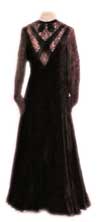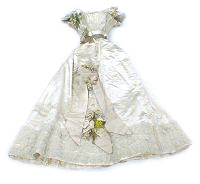 |
Dresses
How many times in a day do you change your clothes? Kathleen O'Reilly changed her clothes many times a day. In fact, she changed every time she started a new activity, such as playing the piano or playing a game of tennis. Some of the dresses Kathleen may have worn include morning dresses, day dresses, tea gowns, dinner/evening dresses, walking costumes, riding costumes, tennis dresses, and even a dress for riding a bike!
Since Kathleen needed many different outfits during the day, it was necessary for the O'Reilly family to re-use the dresses that Kathleen wore. Old evening dresses could be altered for a special occasion to make them look extra-ordinary. For example, Kathleen's presentation gown, the way it looks now, was not bought from a store. An old evening dress was used to make the presentation gown. Flowers and lace were added. A piece of fabric from the back of the waist that fell to the floor and dragged behind the dress, called a train, was added too. Dresses that were too fancy could be modified so that Kathleen could wear them as an evening gown or a tea gown. After Kathleen was presented, her presentation gown was altered again. Sometimes dresses would be out of style or fashion and would be modified to make them more "up to date."
The Royal British Columbia Museum still has some of the dresses that Kathleen wore. Photographs taken of Kathleen show some examples of these costumes. Below are three examples of dresses that we know Kathleen wore in the late 1800's.
 Kathleen's Day Dress Kathleen's Day Dress
Kathleen would have worn her day dress in the daytime to do chores and tasks. It is a plain dress made of cotton. Cotton is easy to wash. It is a loose fitting outfit so the person wearing it could move around easily. .
Day dresses usually had buttons sewn down the front so the dress was easy to get on and off. The dresses were made in different colours and patterns ranging from bright blue with red stripes to plain white.
If Kathleen had visitors, she would wear something a bit fancier.
Kathleen's Evening Gown

The gown you see in this picture is much fancier than the day dress. It is made of expensive fabrics such as velvet and lace. The dress was made for Kathleen to look fashionable and pretty.
Evening gowns were not always comfortable. Many times the gowns were fitted so tight it was hard for the woman wearing it to breathe. A corset was worn under the dress and it pulled a woman's waist very tight and small. Kathleen had a 22" waist. Some evening gowns had a matching "ball bodice," an attachment to go around the waist, which would make the dress look even fancier. If the bodice was taken off, the dress was used for an afternoon dress.
Kathleen would have worn this dress during formal dinners and evening activities such as games or music. A formal dinner usually took place when the O'Reilly's had visitors or if they were making a special visit to a friend's home.
 Kathleen's Presentation Gown Kathleen's Presentation Gown
This dress was made especially for Kathleen. It more unique than the evening gown. It had a beautiful train and was covered in tiny flowers. It almost looks like a wedding dress and was almost as important as one. Kathleen wrote a letter to her parents explaining the dress in detail. Read it to find out how much work was put in to making the dress.
This dress needed to be special because Kathleen wore it to be presented to Royalty. In February of 1897 she was presented to Lord Lieutenant and Countess Cordogan of Dublin Eire. After meeting them, she would have been presented to Royalty at Buckingham Palace, but it never happened, no one knows why.
Kathleen was a source of pride for the O'Reilly family. Once Kathleen's younger sister Mary (Pop) had died, Kathleen was the only daughter to be presented to the world. For this reason, Kathleen may have received more expensive and fancier clothes than other girls her age would have.
Kathleen's wardrobe made a statement to the world about her family's social class, in other words, how rich they were and what other people thought of them, or their wealth and reputation. Her fancy clothes told people around Victoria that the O'Reilly family were in a higher social class.
|
 |
 |